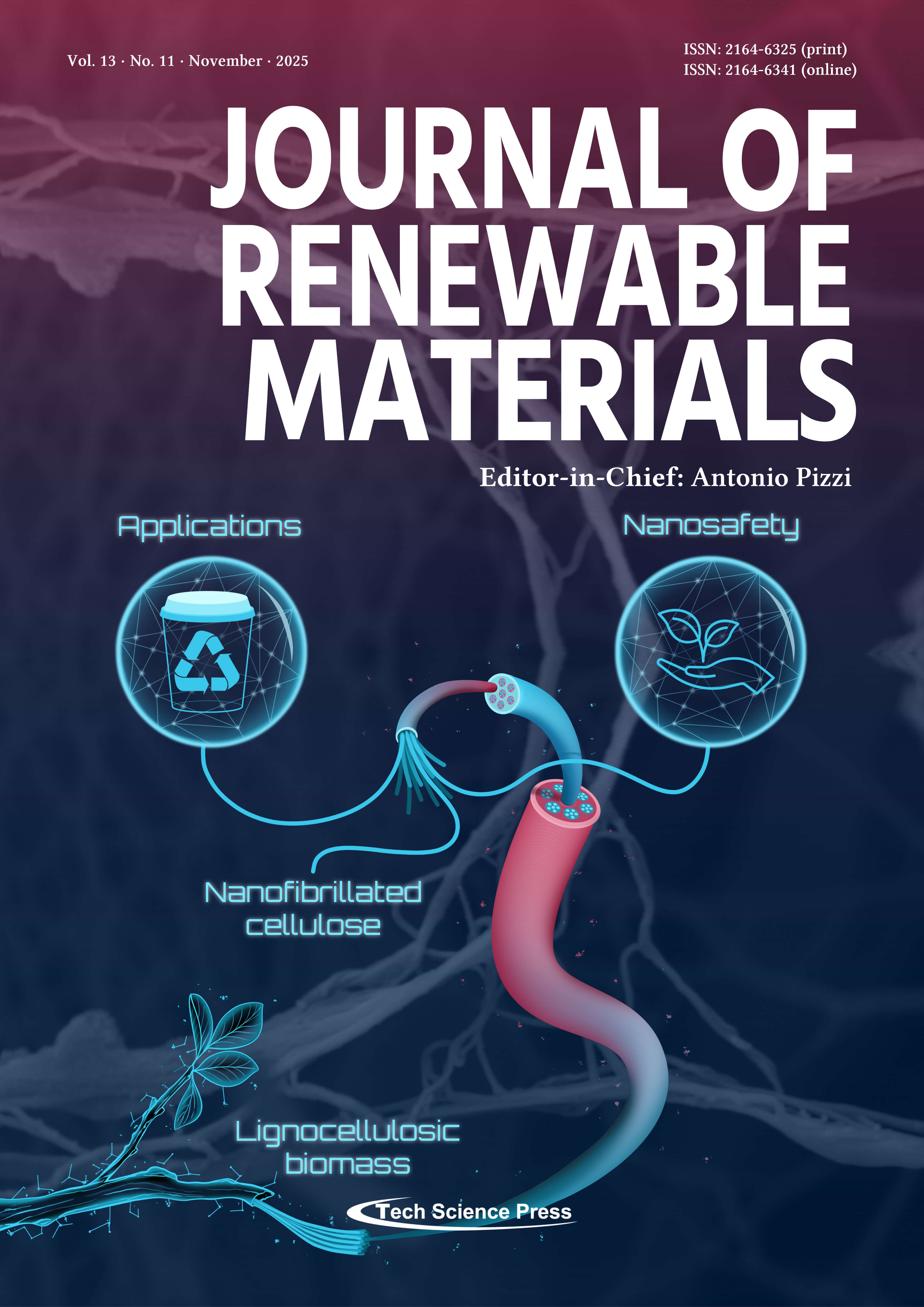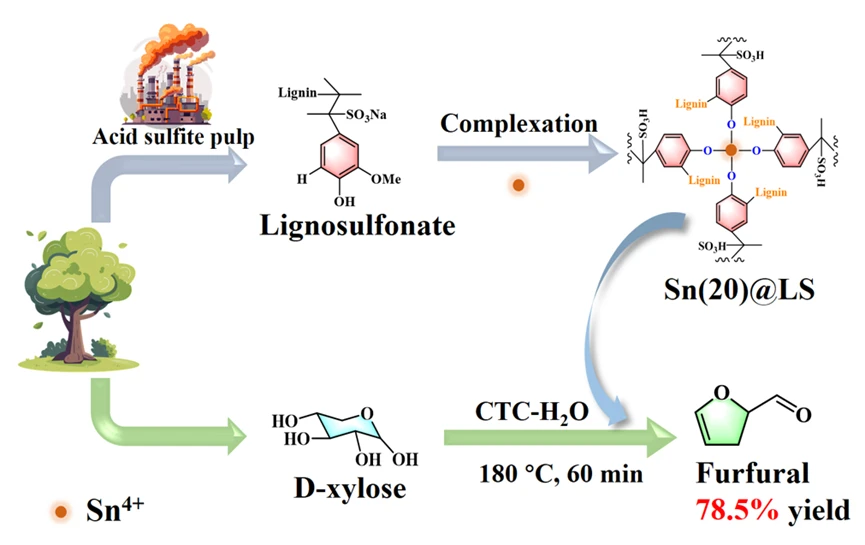
The Journal of Renewable Materials (JRM) is an interdisciplinary journal publishing original research covering all aspects of renewable materials, namely bio-based materials, sustainable materials, green chemistry and including recycling and recovery of spent materials. The scope of the journal is devoted to reports of new and original experimental and theoretical research in the areas of materials, engineering, physics, bioscience, processing, environmental science and chemistry, which are related to renewable materials and their applications.
Ei Compendex/Engineering Village (Elsevier); Scopus Citescore (Impact per Publication 2024): 4.9; SNIP (Source Normalized Impact per Paper 2024): 0.592; Google Scholar h5-index 31, ranking 5 in Wood Science &Technology; Chemical Abstracting Services; Polymer Library; Baidu Xueshu (China); Portico, etc...
Notice: Please make new submissions of JRM to the new system (ScholarOne) (https://mc03.manuscriptcentral.com/jrenewmater) from 25 September 2024. To view your previous submissions, please access TSP system (https://ijs.tspsubmission.com/homepage).
 Open Access
Open Access
ARTICLE
Journal of Renewable Materials, Vol.13, No.11, pp. 2091-2107, 2025, DOI:10.32604/jrm.2025.02025-0060 - 24 November 2025
Abstract It is highly attractive for the catalysts prepared from renewable materials and/or industrial by-products. Herein, lignosulfonate (LS) as the by-product in the papermaking industry was utilized to fabricate Sn-containing organic-inorganic complexing catalysts (Sn(x)@LS) by a simple hydrothermal self-assembly process. The fabricated Sn(x)@LS played an excellent performance in the dehydration of xylose into furfural in the carbon tetrachloride (CTC)-water biphasic system, yielding 78.5% furfural at 180°C for 60 min. It was revealed that strong coordination between Sn4+ and the phenolic hydroxyl groups of LS created a robust organic-inorganic skeleton (-Ar-O-Sn-O-Ar-), simultaneously generating potent Lewis acidic sites, and More >
Graphic Abstract

 Open Access
Open Access
REVIEW
Journal of Renewable Materials, Vol.13, No.11, pp. 2109-2137, 2025, DOI:10.32604/jrm.2025.02025-0069 - 24 November 2025
Abstract The global demand for renewable and sustainable non-petroleum-based resources is rapidly increasing. Lignocellulosic biomass is a valuable resource with broad potential for nanocellulose (NC) production. However, limited studies are available regarding the potential toxicological impact of NC. We provide an overview of the nanosafety implications associated mainly with nanofibrillated cellulose (CNF) and identify knowledge gaps. For this purpose, we present an analysis of the studies published from 2014 to 2025 in which the authors mention aspects related to toxicity in the context of packaging. We also analyze the main methods used for toxicity evaluations and… More >
Graphic Abstract

 Open Access
Open Access
ARTICLE
Journal of Renewable Materials, Vol.13, No.11, pp. 2139-2154, 2025, DOI:10.32604/jrm.2025.02025-0107 - 24 November 2025
(This article belongs to the Special Issue: Advances in Eco-friendly Wood-Based Composites: Design, Manufacturing, Properties and Applications)
Abstract Growing environmental concerns and the need for sustainable alternatives to synthetic materials have led to increased interest in bio-based composites. This study investigates the development and characterization of sustainable egg packaging waste (EPW) biocomposites derived from recycled wood fibers and fungal mycelium filaments as a natural binder. Three formulations were prepared using EPW as the primary substrate, with and without the addition of hemp shives and sawdust as co-substrates. The composites were evaluated for granulometry, density, mechanical strength, hygroscopic behavior, thermal conductivity, and fire performance using cone calorimetry. Biocomposites, composed exclusively of egg packaging waste,… More >
 Open Access
Open Access
ARTICLE
Journal of Renewable Materials, Vol.13, No.11, pp. 2155-2168, 2025, DOI:10.32604/jrm.2025.02025-0111 - 24 November 2025
Abstract Nitrogen-doped activated carbon (N-AC) was successfully prepared by KOH-activation and nitrogen doping using ammonia (NH3) heat treatment. Coconut shell-derived activated carbon (AC) was heat-treated under NH3 gas in the temperature range of 700°C–900°C. Likewise, the mixture of potassium hydroxide (KOH) and AC was heated at 800°C, followed by heat treatment under NH3 gas at 800°C (hereafter referred to as KOH-N-AC800). Scanning electron microscopy (SEM), Raman spectroscopy, X-ray photoelectron spectroscopy (XPS) and Brunauer-Emmett-Teller (BET) method were utilized to analyze morphology, crystallinity, chemical bonding, chemical composition and surface area. The surface area and porosity of N-AC increased with increasing… More >
 Open Access
Open Access
ARTICLE
Journal of Renewable Materials, Vol.13, No.11, pp. 2169-2190, 2025, DOI:10.32604/jrm.2025.02025-0044 - 24 November 2025
Abstract This study evaluates the effectiveness of microwave technology in producing activated carbon from lemongrass waste, an underutilized agricultural byproduct. Microwave-assisted production offers faster heating, lower energy consumption, and better process control compared to conventional methods. It also enhances pore development, resulting in larger, cleaner, and more uniform pores, making the activated carbon more effective for adsorption. The microwave-assisted process significantly accelerates production, reducing the required time to just 10 min at a power of 400 W. Activated carbon derived from lemongrass waste at 400 W exhibits a water absorption capacity of 7.88%, ash content of… More >
Graphic Abstract

 Open Access
Open Access
REVIEW
Journal of Renewable Materials, Vol.13, No.11, pp. 2191-2233, 2025, DOI:10.32604/jrm.2025.02025-0112 - 24 November 2025
(This article belongs to the Special Issue: Biochar Based Materials for a Green Future)
Abstract Increased human and industrial activities have exacerbated the release of toxic materials and acute environmental pollution in recent times. Biochar, a carbon-rich material produced from biomass, is gaining momentum as a versatile material for attaining a sustainable environment. The study reviews the application of functionalized biochar for energy storage, environmental remediation, catalysis, and sustainable agriculture, aiming to achieve a greener future. The deployment of crop residues as a renewable feedstock for biochar, and their properties, compositions, modification, and functionalization techniques are also discussed. Additionally, the avenues for applying functionalized biochar to achieve a greener future,… More >
Graphic Abstract

 Open Access
Open Access
ARTICLE
Journal of Renewable Materials, Vol.13, No.11, pp. 2235-2252, 2025, DOI:10.32604/jrm.2025.02025-0128 - 24 November 2025
(This article belongs to the Special Issue: Advances in Eco-friendly Wood-Based Composites: Design, Manufacturing, Properties and Applications)
Abstract The use of wood-polymer composites (WPC) based on a polymer matrix and wood filler is a modern, environmentally friendly direction in material science. However, untreated wood filler exhibits poor adhesion to hydrophobic polymers due to its hydrophilic lignocellulose fibers. To address this, ozone treatment is employed to enhance compatibility, reduce water absorption, and regulate biodegradation rates. This study investigates the hypothesis that ozone modification of wood filler improves adhesion to thermoplastic starch, thereby enhancing the physico-mechanical properties and controlled biodegradation of WPCs under compost conditions. A comprehensive analysis was conducted on composites containing untreated and… More >
 Open Access
Open Access
ARTICLE
Journal of Renewable Materials, Vol.13, No.11, pp. 2253-2279, 2025, DOI:10.32604/jrm.2025.02025-0058 - 24 November 2025
(This article belongs to the Special Issue: Advances in Eco-friendly Wood-Based Composites: Design, Manufacturing, Properties and Applications)
Abstract Indonesia, with its vast forested regions, has experienced significant deforestation, adversely affecting the wood industry. As a result, alternative sources of lignocellulosic biomass are required to mitigate this impact. Among the abundant lignocellulosic raw materials in Indonesia, particularly in Sumatra, bamboo stands out as a promising substitute. Bamboo is a highly versatile resource, suitable for various applications, including its use as a composite raw material to replace traditional wood-based products. This research work aimed to investigate and evaluate the characteristics—morphology, anatomy, physical and mechanical properties, chemical composition, starch content, and natural resistance—of three bamboo species:… More >